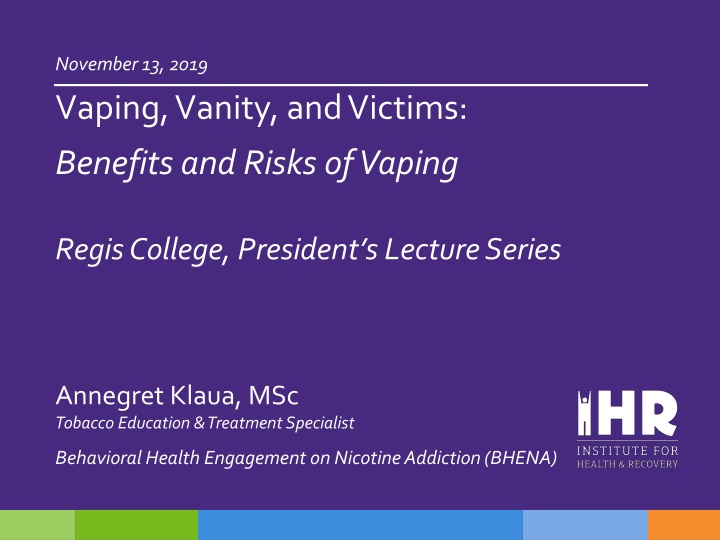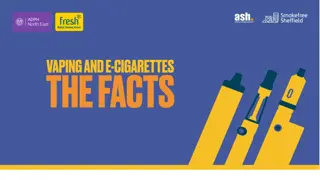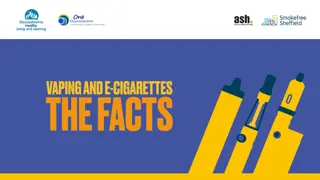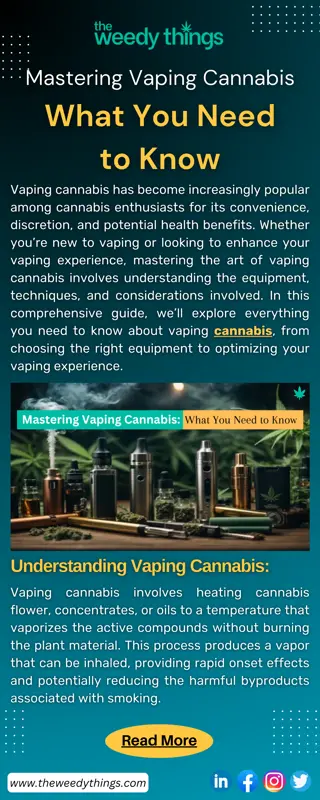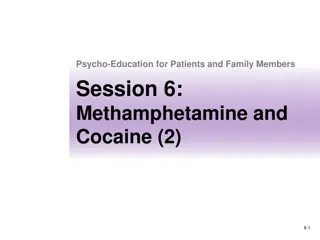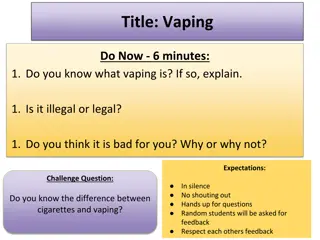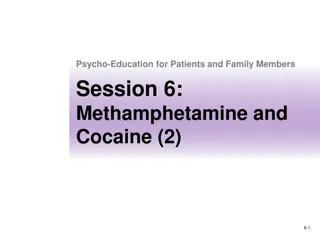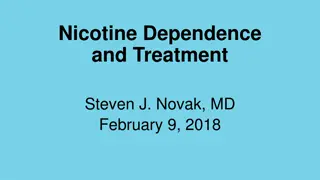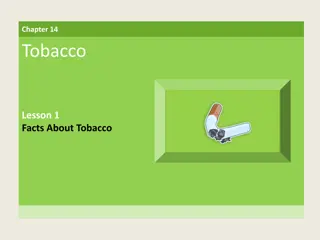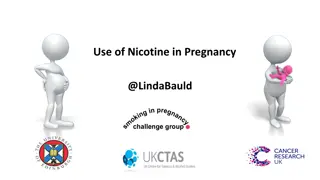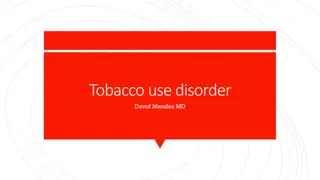Vaping Risks and Nicotine Effects: Understanding the Dangers
Nicotine's impact on the brain and body, the addictive nature of vaping, and the risks for youth. Insights on nicotine levels in e-cigarettes, including JUUL products. Examination of harmful effects on adolescents and recommendations for awareness.
Download Presentation

Please find below an Image/Link to download the presentation.
The content on the website is provided AS IS for your information and personal use only. It may not be sold, licensed, or shared on other websites without obtaining consent from the author.If you encounter any issues during the download, it is possible that the publisher has removed the file from their server.
You are allowed to download the files provided on this website for personal or commercial use, subject to the condition that they are used lawfully. All files are the property of their respective owners.
The content on the website is provided AS IS for your information and personal use only. It may not be sold, licensed, or shared on other websites without obtaining consent from the author.
E N D
Presentation Transcript
November 13, 2019 Vaping, Vanity, and Victims: Benefits and Risks of Vaping Regis College, President s Lecture Series Annegret Klaua, MSc Tobacco Education & Treatment Specialist Behavioral Health Engagement on Nicotine Addiction (BHENA)
Presentation Title Nicotine in the Brain and Body Instructs the brain to release adrenaline Stimulates the central nervous system Increases heart rate and blood pressure Causes constriction in blood vessels throughout the body and decreases blood flow to the heart muscle Releases excess glucose into the bloodstream and inhibits production of insulin This causes more sugar to stay in the blood than is normal and acts as an appetite suppressant 2
Presentation Title Nicotine in the Brain and Body Highly addictive rapid delivery increases its dependence potential Increases levels of several neurotransmitters, including dopamine Symptoms of nicotine toxicity Stomach pain Dizziness Headaches Decreased concentration 3
Presentation Title Youth & Nicotine Attention Learning Addiction Mood disorders Impulse control E-cigarettes induce oxidative stress and the developing brain is particularly vulnerable to its harmful effects. (Tobore J Adolesc 2019) E-cigarettes and dual-product use are significantly associated with greater odds of reporting sleep-related complaints among adolescents. (Riehm et al. J Adolesc 2019) 4
Presentation Title Nicotine Level Chart EU Limit: 20 mg/mL Source: http://www.top-electronic-cigarette.com/electronic-cigarette-e-liquid.html 5
Presentation Title JUUL nicotine content = 59 mg/mL or 35 mg/ml (5% or 3% by weight; lower option released in 2018) JUUL-compatible pods and other pod systems, as well as nicotine salt liquids, come in up to 6.8% nicotine by weight and many more flavors than JUUL ever had Salt-based formula vs. freebase nicotine liquids
Presentation Title (Kirkham. Nicoteen Inc:JUUL disregarded early evidence it was hooking teens. Reuters 11/5/2019) 7
Substantial evidence that e-cigarette use among youth increases risk of cigarette use Presentation Title 2016 2018 Mixed evidence on health consequences Long-term health consequences unknown Limited evidence as a cessation device 8
Presentation Title Recent studies to give us pause E-cigarette aerosol is a lung and potential bladder carcinogen in mice (Tang et al. Proc Natl Acad Sci 2019) Vaping slows wound healing as much as smoking (Troiano et al. JAMA Facial Plast Surg 2019) Current knowledge of population effects is insufficient to determine whether the respiratory health effects of e-cigarettes are less than those of combustible tobacco products (Gotts et al. BMJ 2019) 10
Presentation Title Recent studies to give us pause Chemicals for flavorings like clove, mint and vanilla can harm blood vessel cells that help keep the heart healthy (Fetterman et al. Arterioscler Thromb Vasc Bio 2018) Chemicals cause harm separate from the known harms caused by tobacco A sample of electronic cigarette and smokeless tobacco products had high levels of the mint oil constituent pulegone, banned as a food additive in the U.S. in 2018 (Jabba & Jordt JAMA Intern Med 2019) 11
Presentation Title But I have heard that vaping is 95% safer than smoking(Nutt et al. Eur Addict Res 2014) Not a scientifically proven number Controversial in the public health community people using e-cigarettes are more successful in quitting cigarettes compared to people using NRT (Hajek et al. NEJM 2019) RCT in the UK; 18 mg/mL nicotine for e-cigarettes 1-year abstinence rates: e-cig = 18%, NRT = 9.9% Use after 1 year: e-cig = 80%, NRT = 9% 12
Presentation Title To summarize: Fewer chemicals in e-cigarette liquids compared to cigarettes POTENTIAL BENEFIT: Non-pregnant adult smokers if used as a complete substitute Complicated by uncertainty of EVALI Long-term health effects not yet clear either Not proven as a cessation device, continued addiction to nicotine, potential to be more addictive than cigarettes Effects of nicotine/chemicals SHOULD NOT USE: Youth, YA, pregnant women, adultsnot currently using tobacco Risk of addiction, damage to lungs and cardiovascular system Increases risk of smoking combustible cigarettes in youth 13
Annegret Klaua annegretklaua@healthrecovery.org 617.661.3991 x120
